Microstructure and Mechanical Properties of Hypo- and Hypereutectic Cast Mg/Mg2Si Composites
Abstract
:1. Introduction
2. Materials and Methods
3. Results and Discussion
4. Conclusions
- 1
- Magnesium matrix composites with 1.9 and 19 wt% Mg2Si phase were successfully fabricated by the casting method.
- 2
- The microstructure of the material with 1.9 wt% Mg2Si consisted of primary magnesium dendrites and an Mg + Mg2Si eutectic mixture, whereas the composite with 19 wt% Mg2Si exhibited a primary polygonal Mg2Si compound surrounded by magnesium dendrites and eutectic.
- 3
- The composites exhibited a rise in tensile and yield strength in both the tensile and compression tests with an increase in the weight fraction of the Mg2Si phase.
- 4
- The fracture surface observations revealed that during the uniaxial tensile test, the cracking process of the fabricated composites proceeded through all structural constituents.
Author Contributions
Funding
Conflicts of Interest
References
- Kucharczyk, A.; Naplocha, K.; Tomanik, M. Processing in porous niti preforms for niti/mg composites. Arch. Metal. Mater. 2019, 64, 747–752. [Google Scholar]
- Dolata, A.J.; Dyzia, M.; Boczkal, S. Influence of the Sr and Mg alloying additions on the bonding between matrix and reinforcing particles in the AlSi7Mg/SiC-Cgr hybrid composites. Arch. Metal. Mater. 2016, 61, 651–656. [Google Scholar] [CrossRef] [Green Version]
- Dolata, A.J. Hybrid composites shaped by casting methods. Solid State Phenom. 2014, 211, 47–52. [Google Scholar] [CrossRef]
- Nishida, Y. Introduction to Metal Matrix Composites: Fabrication and Recycling; Springer: Tokyo, Japan, 2013. [Google Scholar] [CrossRef]
- Chawla, N.; Chawla, K.K. Metal Matrix Composites; Springer Science + Media: New York, NY, USA, 2013. [Google Scholar] [CrossRef] [Green Version]
- Braszczyńska-Malik, K.N. Magnesium Alloys and Composites on Their Matrix; Czestochowa University Publisher: Częstochowa, Poland, 2017; ISBN 978-83-7193-674-6. [Google Scholar]
- Braszczyńska, K.N. Contribution of SiC particles to the formation of the structure of Mg-3wt%RE cast composites. Zeitschrift für Metallkunde 2003, 94, 144–148. [Google Scholar] [CrossRef]
- Saravanan, R.A.; Surappa, M.K. Fabrication and characterization of pure magnesium-30 vol.% SiCp particle composite. Mater. Sci. Eng. A 2000, 276, 108–116. [Google Scholar] [CrossRef]
- Bochenek, A.; Braszczyńska, K.N. Structural analysis of the MgAl5 matrix—SiC particles cast composites. Mater. Sci. Eng. A 2000, 290, 122–127. [Google Scholar] [CrossRef]
- Braszczyńska-Malik, K.N.; Przełożyńska, E. Analyses of AM50-Tip metal-metal composite microstructure. J. Alloys Comp. 2018, 731, 1181–1187. [Google Scholar] [CrossRef]
- Braszczyńska-Malik, K.N.; Przełożyńska, E. The influence of Ti particles on microstructure and mechanical properties of Mg-5Al-5RE matrix alloy composite. J. Alloys Comp. 2017, 728, 600–606. [Google Scholar] [CrossRef]
- Godzierz, M.; Olszówka-Myalska, A. Influence of casting procedure on wear of magnesium matrix composites reinforced with carbon open-celled foam. Compos. Theory Pract. 2019, 19, 64–70. [Google Scholar]
- Braszczyńska-Malik, K.N.; Kamieniak, J. AZ91 magnesium matrix foam composites with fly ash cenospheres fabricated by negative pressure infiltration technique. Mater. Charact. 2017, 128, 209–216. [Google Scholar] [CrossRef]
- Braszczyńska-Malik, K.N.; Kamieniak, J. The role of Ni-P coating structure on fly ash cenospheres in the formation of magnesium matrix composites. Metal. Mater. Trans. A 2017, 48A, 5649–5657. [Google Scholar] [CrossRef] [Green Version]
- Chen, K.; Li, Z. Effect of co-modification by Ba and Sb on the microstructure of Mg2Si/Mg–Zn–Si composite and mechanism. J. Alloys Comp. 2014, 592, 196–201. [Google Scholar] [CrossRef]
- Hu, X.S.; Wu, K.; Zheng, M.Y. Effect of heat treatment on the stability of damping capacity in hypoeutectic Mg–Si alloy. Scripta Mater. 2006, 54, 1639–1643. [Google Scholar] [CrossRef]
- Mirshahi, F.; Meratian, M. High temperature tensile properties of modified Mg/Mg2Si in situ composite. Mater. Des. 2012, 33, 557–562. [Google Scholar] [CrossRef]
- Pan, Y.; Liu, X.; Yang, H. Microstructural formation in a hypereutectic Mg–Si alloy. Mater. Charact. 2005, 55, 241–247. [Google Scholar] [CrossRef]
- Mosleh, S.; Emamy, M.; Majdi, H. The effect of Si and extrusion process on the microstructure tensile properties of Mg-Mg2Si Composite. Procedia Mater. Sci. 2015, 11, 79–83. [Google Scholar] [CrossRef] [Green Version]
- Zheng, N.; Wang, H.Y.; Gu, Z.H.; Wang, W.; Jiang, Q.C. Development of an effective modifier for hypereutectic Mg–Si alloys. J. Alloys Comp. 2008, 463, L1–L4. [Google Scholar] [CrossRef]
- Hu, J.; Tang, C.; Zhang, X.; Deng, Y. Modification of Mg2Si in Mg-Si alloys with neodymium. Trans. Nonferrous Met. Soc. China 2013, 23, 3161–3166. [Google Scholar] [CrossRef]
- Seth, P.P.; Singh, N.; Singh, M.; Prakash, O.; Kumar, D. Formation of fine Mg2Si phase in Mg-Si alloy via solid-state sintering using high energy ball milling. J. Alloys Comp. 2020, 821, 153205. [Google Scholar] [CrossRef]
- Niu, X.; Lu, L. Formation of magnesium silicide by mechanical alloying. Adv. Perform. Mater. 1997, 4, 275–283. [Google Scholar] [CrossRef]
- Sun, B.; Li, S.; Imai, H.; Umeda, J.; Kon, K. Synthesis kinetics of Mg2Si and solid-state formation of Mg–Mg2Si composite. Powder Tech. 2012, 2017, 157–162. [Google Scholar] [CrossRef]
- Lu, L.; Thong, K.K.; Gupta, M. Mg-based composite reinforced by Mg2Si. Compos. Sci. Technol. 2003, 63, 627–632. [Google Scholar] [CrossRef]
- Nieroda, P.; Kolezynski, A.; Leszczynski, J.; Nieroda, J.; Pasierb, P. The structural, microstructural and thermoelectric properties of Mg2Si synthesized by SPS method under excess Mg content conditions. J. Alloys Comp. 2019, 775, 138–149. [Google Scholar] [CrossRef]
- Olszówka-Myalska, A.; Wrześniowski, P.; Myalska, H.; Godzierz, M.; Kuc, D. Impact of the morphology of micro- and nanosized powder mixtures on the microstructure of Mg-Mg2Si-CNT composite sinters. Materials 2019, 12, 3242. [Google Scholar] [CrossRef] [PubMed] [Green Version]
- Zhang, W.; Li, X.; Ding, D.; Gao, P. Microstructure and mechanical properties of Mg2Si/AZ91 composites in situ synthesized by using silica fume as the Si source. J. Mater. Eng. Perform. 2018, 27, 5300–5311. [Google Scholar] [CrossRef]
- Mirshahi, F.; Meratian, M.; Panjepour, M. Effect of cooling rate on morphology and distribution of precipitates Mg2Si particles in Mg/Mg2Si composites, Magnesium. In Proceedings of the 8th International Conference on Magnesium Alloys and Their Applications 2009, Weimar, Germany, 26–29 October 2009; Kainer, K.U., Ed.; Wiley-VCH: Weinheim, Germany, 2010; ISBN 978-3-527-32732-4. [Google Scholar]
- Hu, X.S.; Wu, K.; Zheng, M.Y.; Gan, W.M.; Wang, X.J. Low frequency damping capacities and mechanical properties of Mg–Si alloys. Mater. Sci. Eng. A. 2007, 452–453, 374–379. [Google Scholar] [CrossRef]
- Han, W.D.; Li, Y.H.; Li, X.D.; Dai, J.; Li, K. Doping and adsorption mechanism of modifying the eutectic Mg2Si phase in magnesium alloys with rare earth elements: A first-principles study. Appl. Surf. Sci. 2020, 503, 144331. [Google Scholar] [CrossRef]
- Wang, Y.; Guo, X. Heterogeneous nucleation of Mg2Si and Mg2(Si,Sn) on Mg3Sb2 nucleus in Mg containing Si alloys. Mater. Chem. Phys. 2019, 223, 336–342. [Google Scholar] [CrossRef]
- Jiang, Q.C.; Wang, H.Y.; Wang, Y.; Ma, B.X.; Wang, J.G. Modification of Mg2Si in Mg–Si alloys with yttrium. Mater. Sci. Eng. A 2005, 392, 130–135. [Google Scholar] [CrossRef]
- Guo, E.J.; Ma, B.X.; Wang, L.P. Modification of Mg2Si morphology in Mg–Si alloys with Bi. J. Mater. Proc. Tech. 2008, 206, 161–166. [Google Scholar] [CrossRef]
- Shin, H.C.; Son, J.; Min, B.K.; Choi, Y.S.; Cho, K.M.; Cho, D.H.; Park, I.M. The effect of Ce on the modification of Mg2Si phases of as-cast eutectic Mg-Si alloys. J. Alloys Comp. 2019, 792, 59–68. [Google Scholar] [CrossRef]
- Malik, M.; Majchrzak, K.; Braszczyńska-Malik, K.N. Microstructural analysis of AM50/Mg2Si cast magnesium composites. Arch. Foundry Eng. 2012, 12, 109–112. [Google Scholar] [CrossRef]
- Wang, K.Y.; Zhao, R.D.; Wu, F.F.; Wu, X.F.; Chen, M.H.; Xiang, J.; Chen, S.H. Improving microstructure and mechanical properties of hypoeutectic Al-Mg2Si alloy by Gd addition. J. Alloys Comp. 2020, 813, 152178. [Google Scholar] [CrossRef]
- Que, Z.; Wang, Y.; Fan, Z. Heterogeneous nucleation of eutectic structure in Al-Mg-Si alloys. Metal. Mater. Trans. A 2020, 51, 2697–2702. [Google Scholar] [CrossRef] [Green Version]
- Shafieizad, A.H.; Zarei-Hanzaki, A.; Abedi, H.R.; Al-Fadhalah, K.J. The Mg2Si phase evolution during thermomechanical processing of in-situ aluminum matrix macro-composite. Mater. Sci. Eng. A 2015, 644, 310–317. [Google Scholar] [CrossRef]
- Zainon, F.; Ahmad, K.R.; Daud, R. The effects of Mg2Si(p) on microstructure and mechanical properties of AA332 composite. Adv. Mater. Res. 2016, 5, 55–66. [Google Scholar] [CrossRef]
- Chegini, M.; Shaeri, M.H.; Taghiabadi, R.; Chegini, S.; Djavanroodi, F. The correlation of microstructure and mechanical properties of in-situ Al-Mg2Si cast composite processed by equal channel angular pressing. Materials 2019, 12, 1553. [Google Scholar] [CrossRef] [Green Version]
- Ghandvara, H.; Idris, M.H.; Abu Bakar, T.A.; Nafari, A.; Ahmad, N. Microstructural characterization, solidification characteristics and tensile properties of Al–15%Mg2Si–x(Gd–Sb) in-situ composite. J. Mater. Technol. 2020, 9, 3272–3291. [Google Scholar] [CrossRef]
- Zhu, X.; Yang, H.; Dong, X.; Ji, S. The effects of varying Mg and Si levels on the microstructural inhomogeneity and eutectic Mg2Si morphology in die-cast Al–Mg–Si alloys. J. Mater. Sci. 2019, 54, 5773–5787. [Google Scholar] [CrossRef] [Green Version]
- Kamieniak, J.; Braszczyńska-Malik, K.N. Problems fabricating cast magnesium matrix composites with aluminosilicate cenospheres. Compos. Theory Pract. 2014, 14, 214–218. [Google Scholar]
- Braszczyńska-Malik, K.N.; Kamieniak, J. Analysis of interface between components in AZ91 magnesium alloy foam composite with Ni-P coated fly ash cenospheres. J. Alloys Comp. 2017, 720, 352–359. [Google Scholar] [CrossRef]
- Jiang, W.; Wang, J.; Yu, W.; Ma, Y.; Guo, S. In-situ formation of a gradient Mg2Si/Mg composite with good biocompatibility. Surf. Coat. Tech. 2019, 361, 255–262. [Google Scholar] [CrossRef]
- Liu, J.; Zhang, L.; Liu, S.; Han, Z.; Dong, Z. Effect of Si content on microstructure and compressive properties open cell Mg composite foams reinforced by in-situ Mg2Si compounds. Mater. Charact. 2020, 159, 110045. [Google Scholar] [CrossRef]
- Thermo-Calc Software AB, TCS Mg-Based Alloys Database, Version 4.0; TCMG: Stockholm, Sweden, 2015.
- ICDD. Powder Diffraction File, PDF-4+; International Centre for Diffraction Data: Pennsylvania, PA, USA, 2015. Available online: https://www.icdd.com/ (accessed on 14 August 2020).
- Braszczyńska-Malik, K.N.; Grzybowska, A. Influence of phase composition on microstructure and properties of Mg-5Al-0.4Mn-xRE (x = 0, 3 and 5 wt.%) alloys. Mater. Charact. 2016, 115, 14–22. [Google Scholar] [CrossRef]


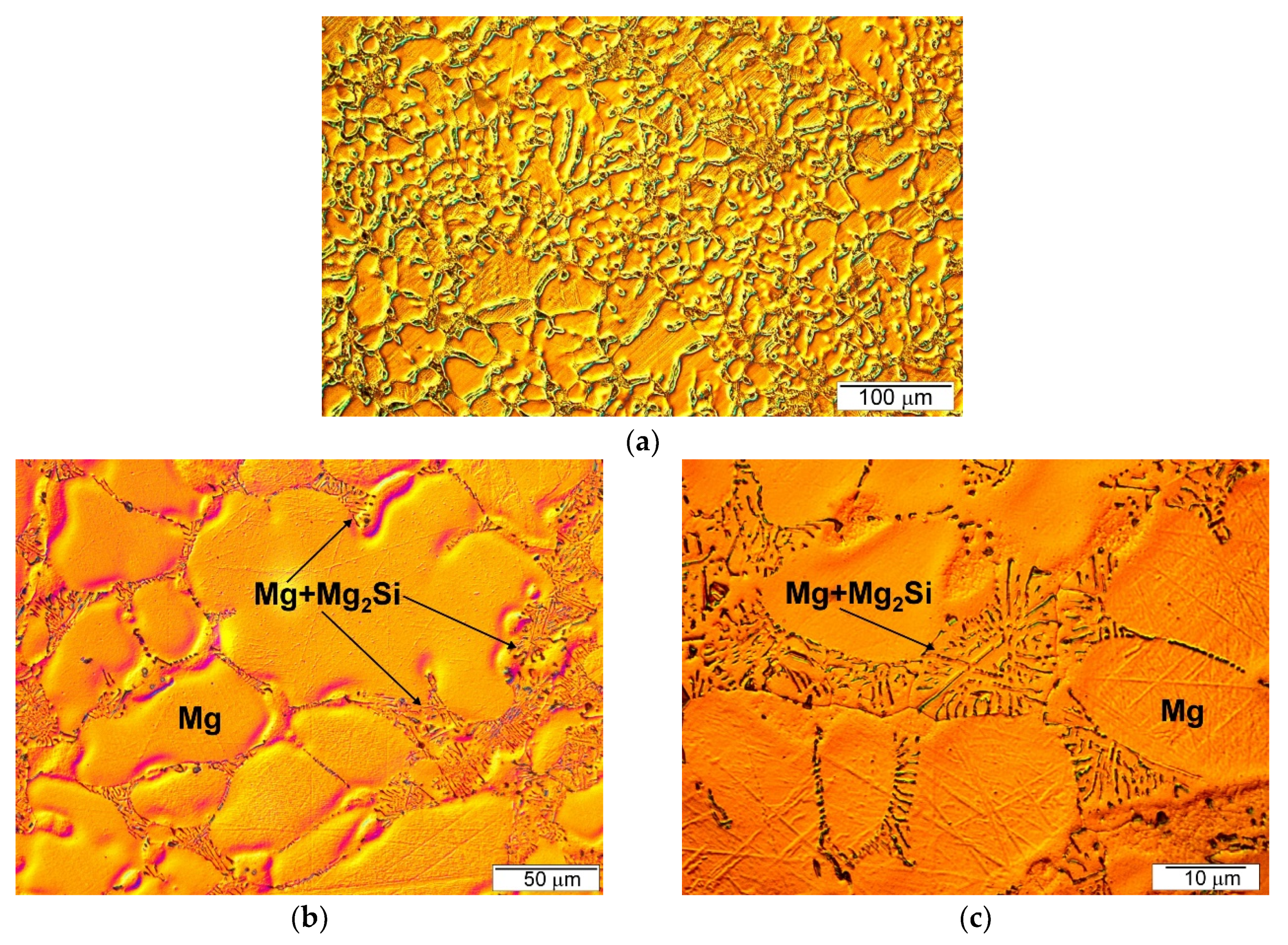
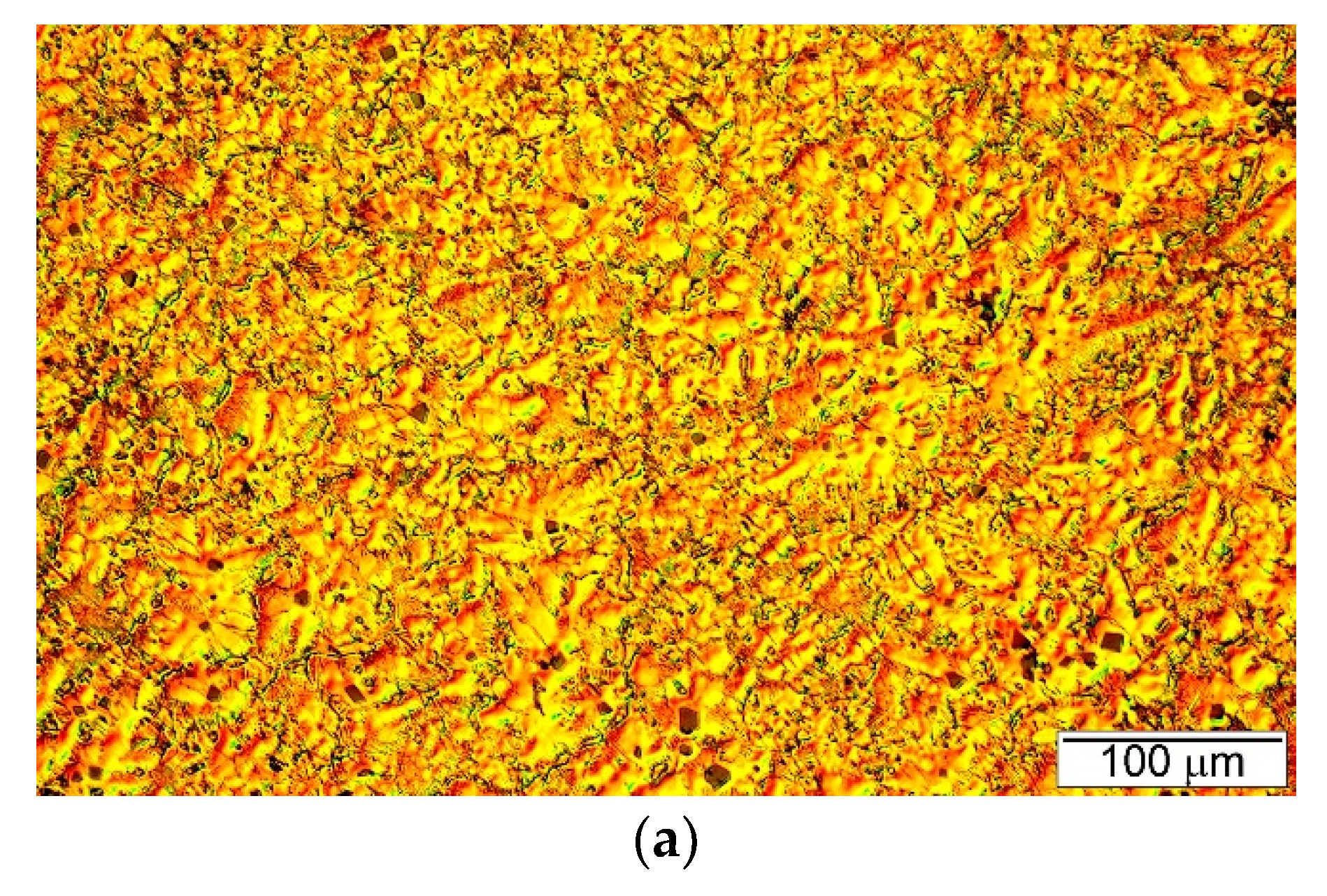

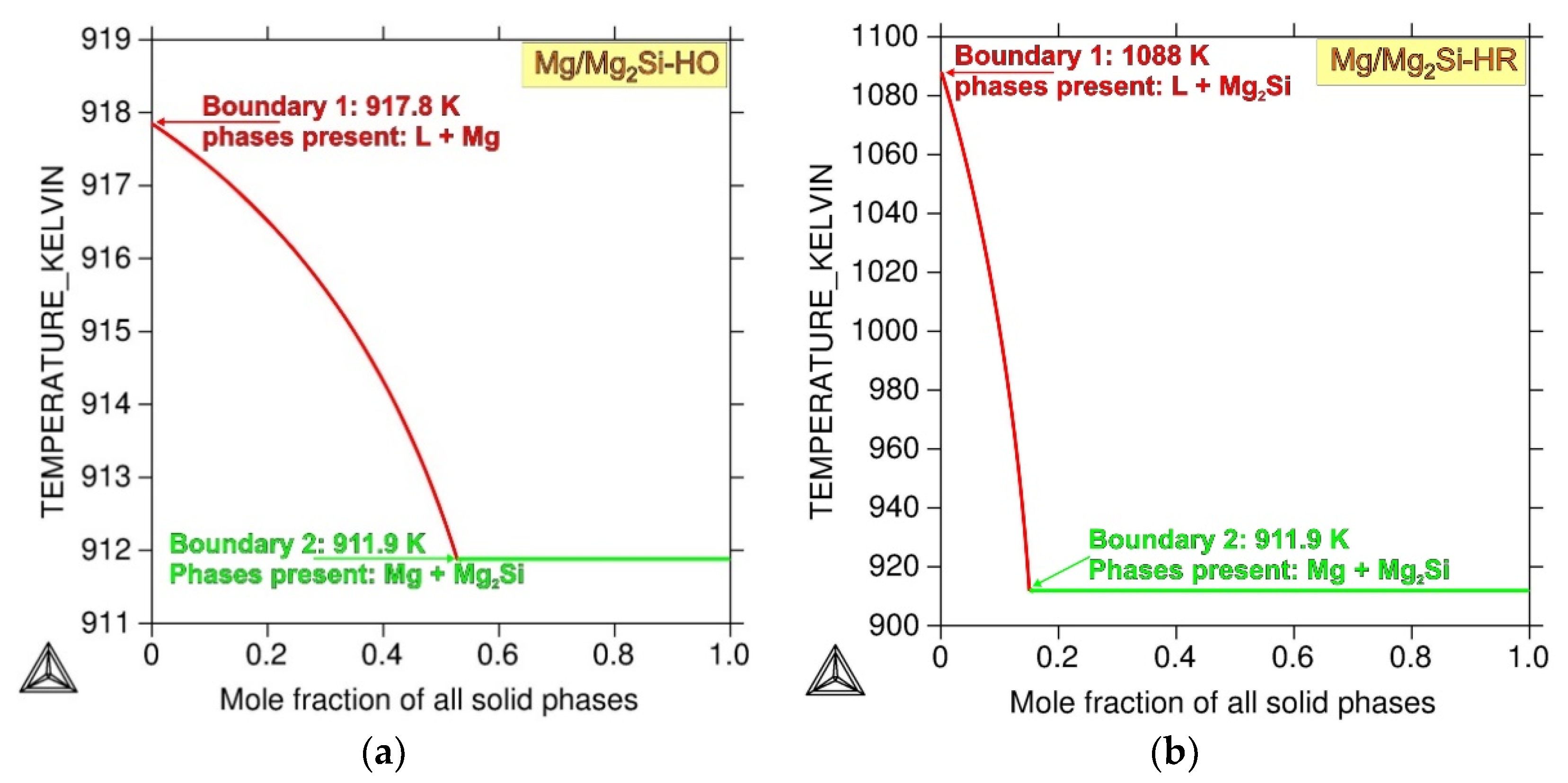

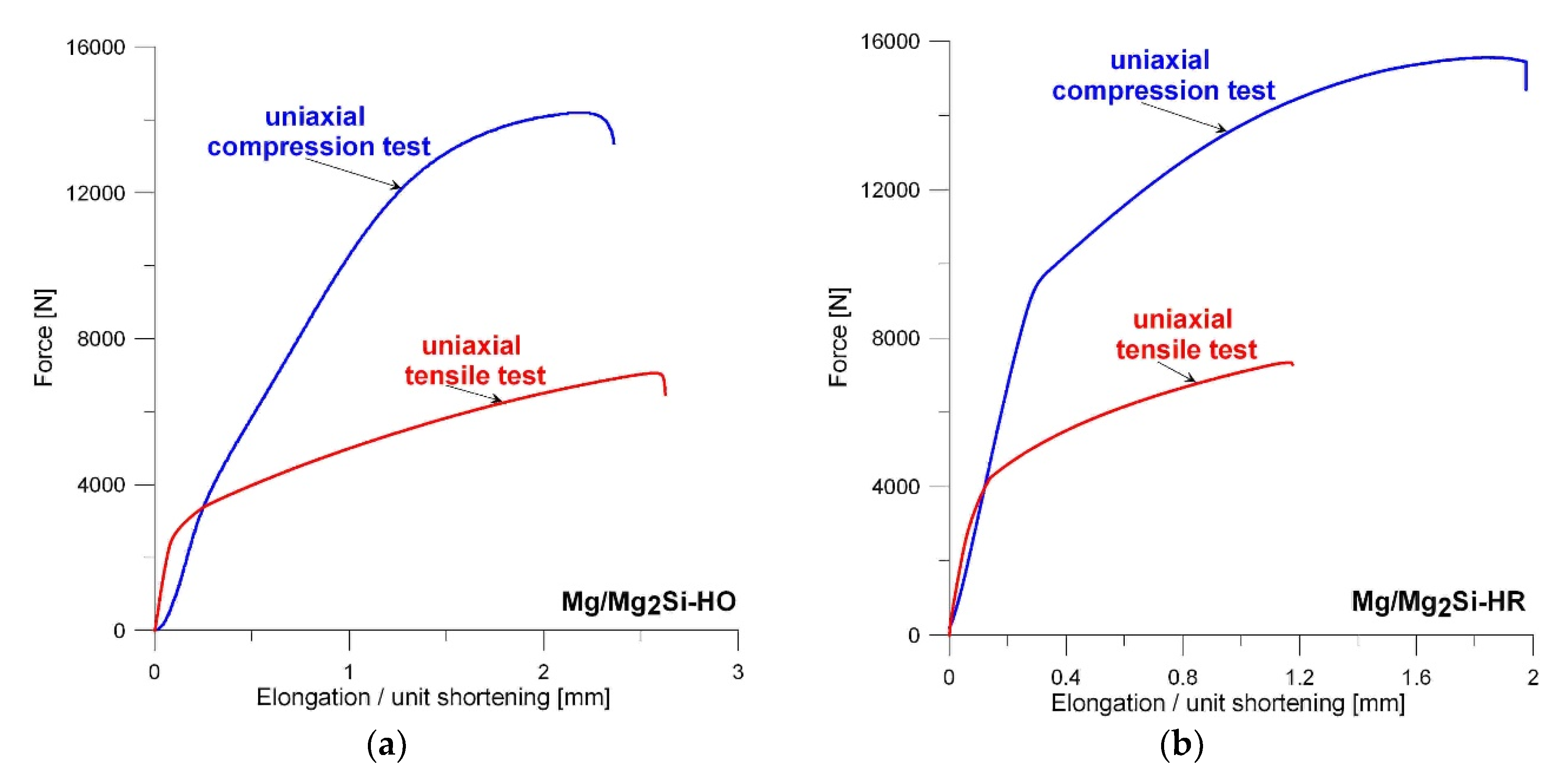
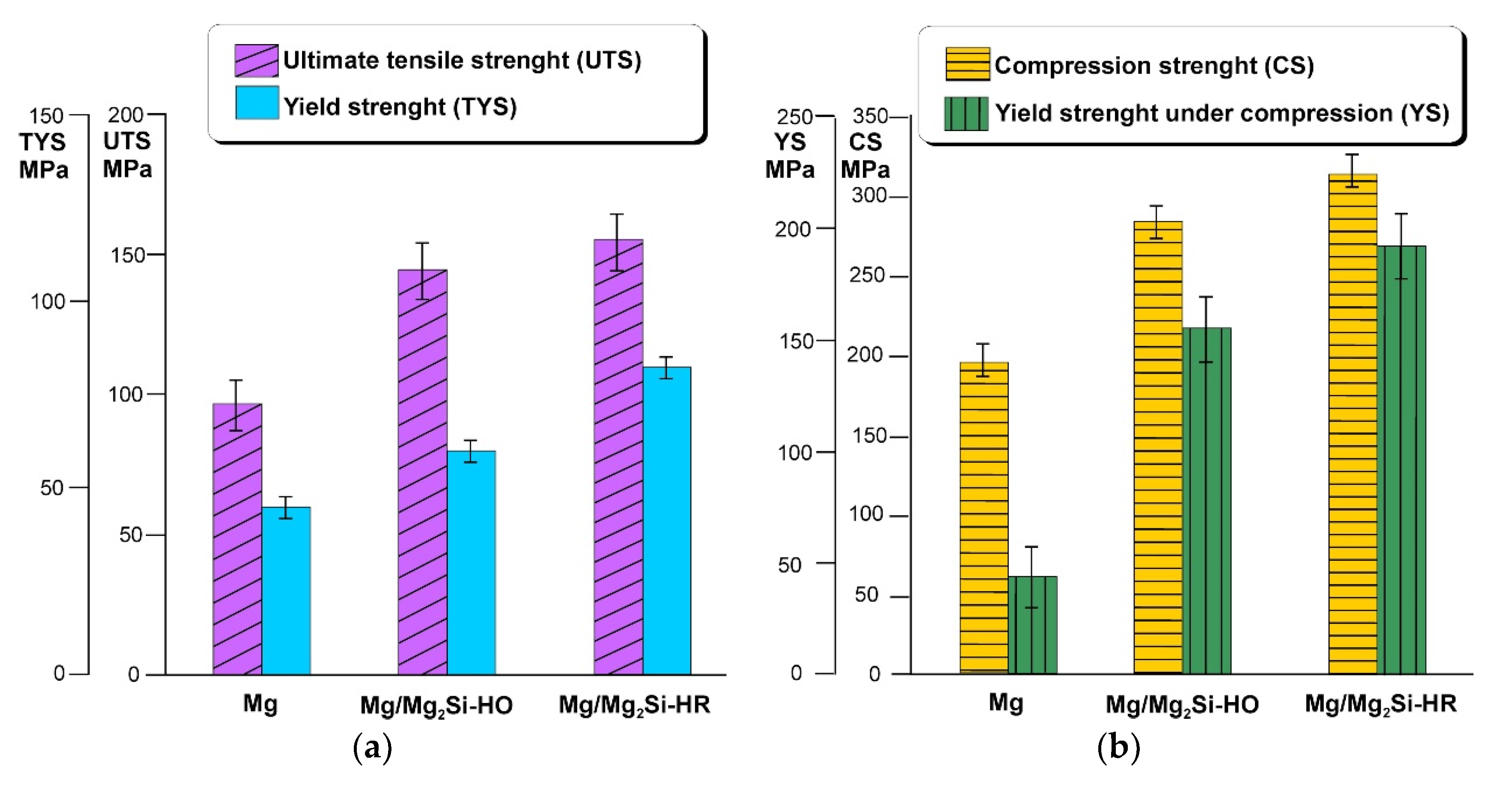
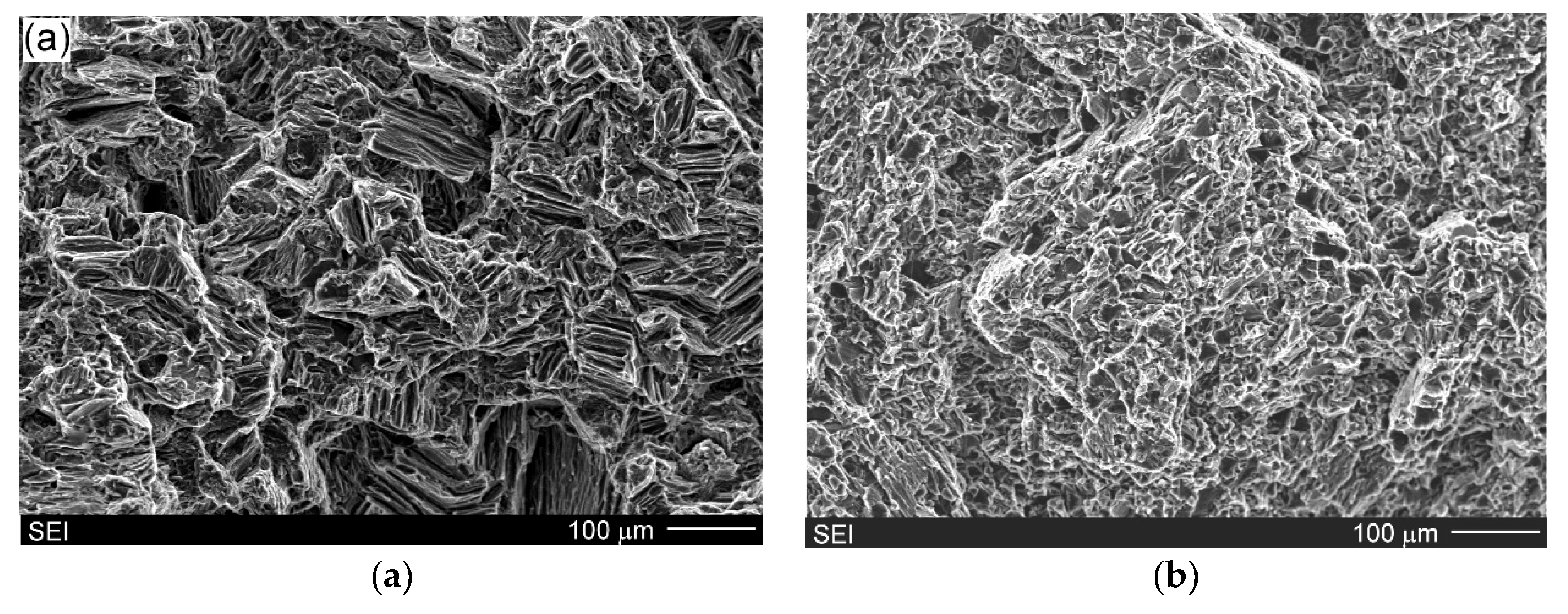

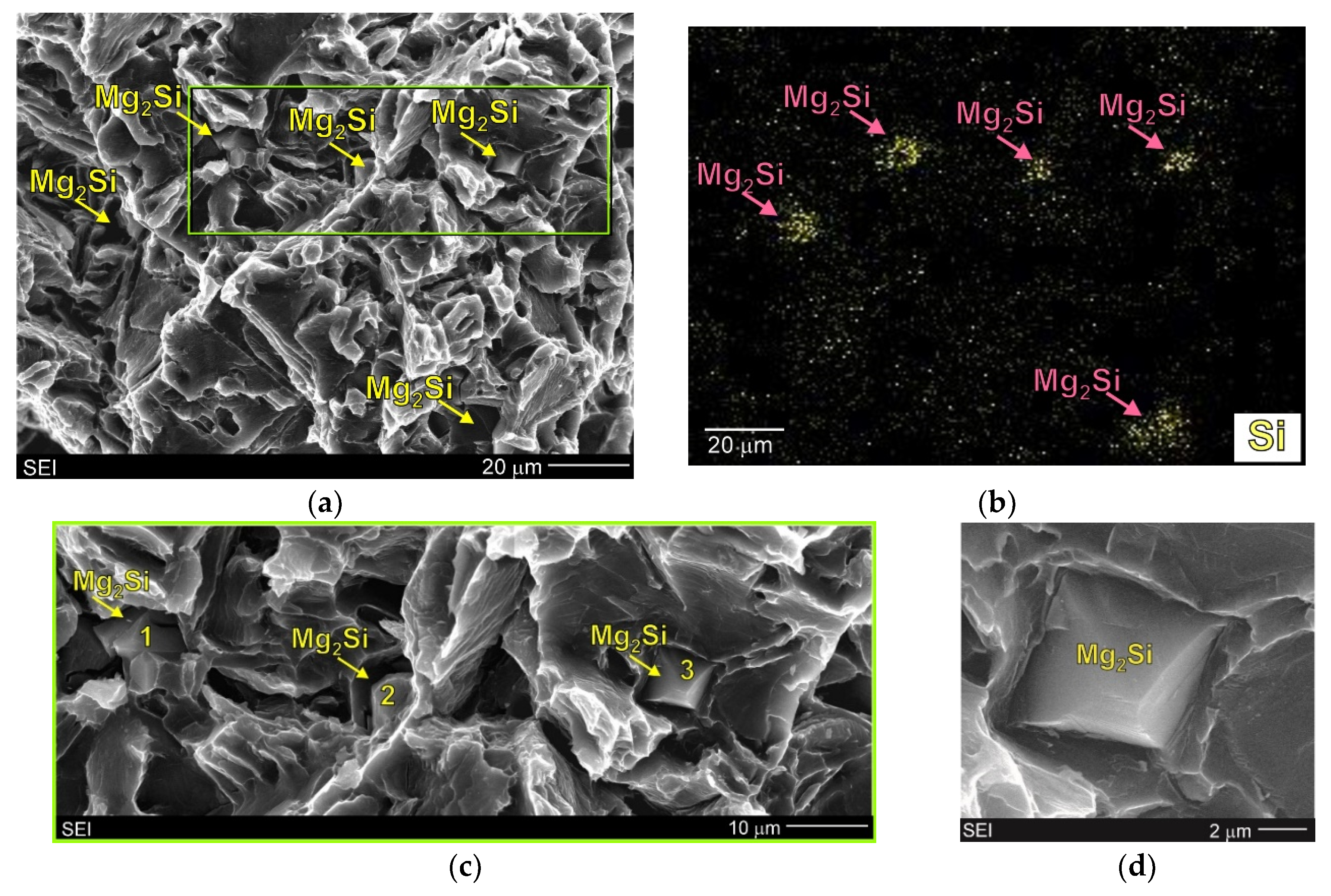

© 2020 by the authors. Licensee MDPI, Basel, Switzerland. This article is an open access article distributed under the terms and conditions of the Creative Commons Attribution (CC BY) license (http://creativecommons.org/licenses/by/4.0/).
Share and Cite
Braszczyńska-Malik, K.N.; Malik, M.A. Microstructure and Mechanical Properties of Hypo- and Hypereutectic Cast Mg/Mg2Si Composites. Materials 2020, 13, 3591. https://doi.org/10.3390/ma13163591
Braszczyńska-Malik KN, Malik MA. Microstructure and Mechanical Properties of Hypo- and Hypereutectic Cast Mg/Mg2Si Composites. Materials. 2020; 13(16):3591. https://doi.org/10.3390/ma13163591
Chicago/Turabian StyleBraszczyńska-Malik, Katarzyna N., and Marcin A. Malik. 2020. "Microstructure and Mechanical Properties of Hypo- and Hypereutectic Cast Mg/Mg2Si Composites" Materials 13, no. 16: 3591. https://doi.org/10.3390/ma13163591



